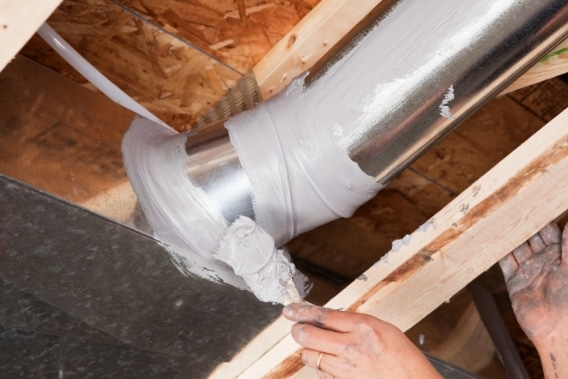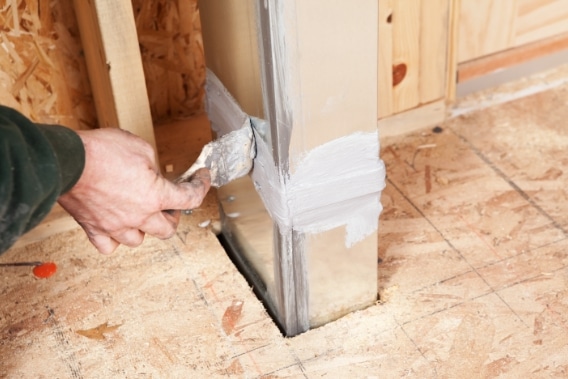Read on to learn more about the duct sealing process from the inside and why you should consider it.
Importance of Duct Sealing
With duct sealing, you can have peace of mind knowing that you’ll have a better home airflow and enjoy a healthier, cleaner, and more comfortable home.
Some of the main benefits of duct sealing include:
- Lower energy consumption
- Improve air quality
- Increase your comfort
Problems Caused by Unsealed Ducts
One of the many problems caused by a leaking air duct is energy waste. Most homeowners rarely realize that the cooling and heating losses through unsealed ducts can contribute to their home’s discomfort. Duct leaks make it difficult for your system to maintain desired temperatures in your living space.

When attic or crawlspace air gets into your system, the dirt and other particles inside the unconditioned air can build-up inside your system’s evaporator coil. Because the AC runs most of the time in a year, the evaporator coil stays wet.
These conditions can lead to microbial growth on the coil. This not only smells bad, but it’s also not healthy to breathe.
Why Should You Opt for Duct Sealing From the Inside?
From failed foil tapes to unsealed duct connections, there are countless escape routes through which your precious, bought-and-paid-for conditioned air gets out. That’s why most residential heating and cooling systems are leaky. However, duct sealing from the inside makes it easy for you to enjoy the desired temperatures in your home.

Leaks in your ducts can reduce your system’s effectiveness by as much as 20%. When you seal and insulate your ducts, you can increase your system’s efficiency and lower your energy bills. What’s more, this often pays for itself in energy savings.
Are you planning to install a new heating system? A well-designed and sealed duct from the inside can help you downsize to a less expensive system that can provide better dehumidification. Leaks in your ducts leave room for the dirty air to enter your heating or cooling equipment. If your blower is in your attic, a leaky duct will circulate attic air rather than conditioned air throughout your home.
This situation can pose a high health risk because you’ll be breathing a high concentration of dust and other atmospheric pollutants. Sealing your ducts from the inside prevents such scenarios. Therefore, you’ll rest easy knowing that you’ll keep your home’s air clean and healthy.
Duct Sealing From the Inside vs Professional Duct Sealing
Homeowners most often wonder whether they can conduct duct sealing all by themselves or if they need to call in a professional. Both options have pros and cons, and it comes down to your capability. Before you start this vital task, you need to know the most common errors and the best methods when sealing your ducts from the inside.
If you decide to do it yourself, you can test for duct leaks with a thin piece of toilet paper or an incense stick. Hold up a lit incense stick next to your duct while the system is on. If the smoke or toilet paper starts moving erratically, you have a leaky duct. When sealing the air duct, you can use a mastic sealant. If you prefer using tape, the aluminum foil tape can help you get the work done.
However, as with most HVAC related systems, it’s always advisable to hire a professional when looking for more than just a simple seal with aluminum foil tape or mastic sealant.
When to Call a Professional
Suppose your air ducts are in a difficult location, such as the basement. In that case, a professional can assess the situation and develop an effective way of accessing and repairing the leak. Professional duct sealing contractors use modern technology to seal your ducts from the inside.
That’s a surefire way of ensuring they cover every single opening. Qualified technicians will also help you insulate your air ducts for more significant savings. This is essential, especially if your ductwork runs in basements, attics, and other unconditioned spaces.
The Process of Duct Sealing From the Inside
Today, most heating and cooling companies use Aeroseal to seal up leaking ductwork. With this product, technicians don’t need to crawl through your ducts, meaning less work for them and fewer costs for you.

The tiny particles remain suspended in the air until they’re drawn to a leak. When they try to escape, they’ll stick to the edges of holes and cracks. With time, enough particles build-up on the leaks, sealing them in the process.
Finally, your technician will conduct a second test to measure the efficiency of the sealing treatment. In addition to being useful in sealing your air ducts, the sealant is odorless and comes with a 10-year warranty.
World-Class Duct Sealing Services
At McGowan’s Heating & Air Conditioning, we can assess and locate the hidden leaky duct issues for residents in Northeast Florida. Our licensed and NATE-certified heating and cooling technicians can correctly diagnose your system and offer a cost-effective, state-of-the-art solution to your duct problems. We also offer a wide range of heating and cooling services, such as AC maintenance, AC repairs, and AC installations.
Contact McGowan’s Heating & Air Conditioning today for more information on duct sealing from the inside for your home or business.



